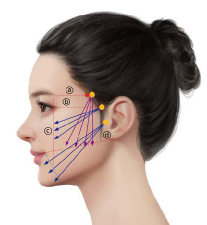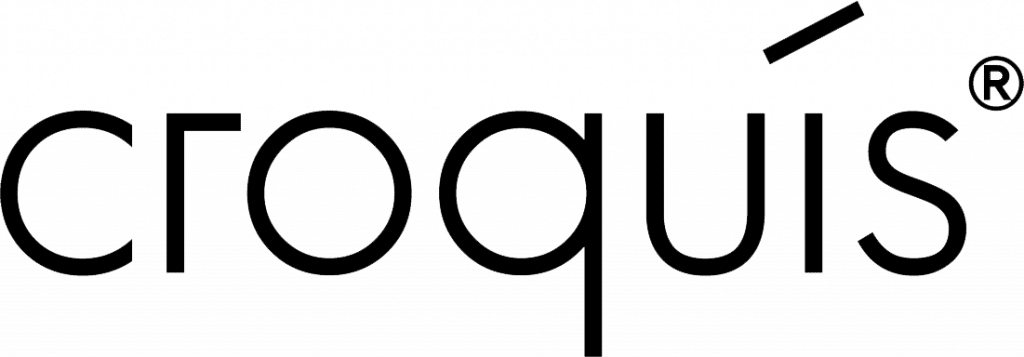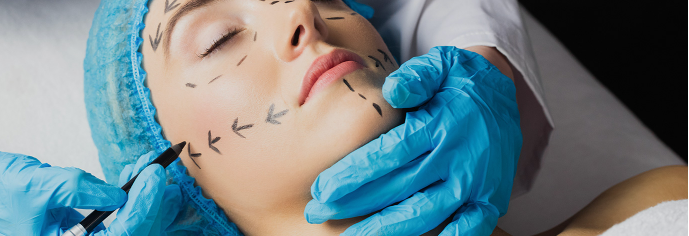Draw your beauty, Capture the moment

Understanding of the thread lifting
To achieve a successful thread lifting treatment, it is necessary to understand the principles of thread lifting. To be more precise, it is correct to describe the thread lifting as ‘replacement’ of the superficial fat rather than ‘lifting’ of the face. Facelift surgery is to pull all the soft tissue on the face, including SMAS, Thread lifting, on the other hand is to move the skin tissue and superficial fat compartment slightly upwards or outwards
An effective lifting treatment must be based on thorough understanding of changes to the face due to aging. In addition, it is necessary to clarify the definition and meaning of three important terms in absorbable thread-lifting.
Fixing Point
The concept of the fixing point is important when performing thred lifting procedures. A fixing point means the point which receives the pulling force when a certain part of the face is being pulled. To optimize lifting effects, pulling must be done in a proper direction and a strong fixing point must exist from the pulling direction.
This is because force must support in the opposing direction from the downward movement of the tissues resulting from aging and gravity. In general, fixing a thread in the fascia is thought to be the strongest fixation technique. However, this technique is not easy to perform due to the high risk of bleeding or hematoma.
After inserting a bi-directional cog thread, tying the threads to each other at the entry point can play a role as a fixing point. There is also a method of creating a fixing point using the hard ligament tissue in the inner side of the face. By causing the cog thread to be hung in the area of the true ligament, a hard fixing point can be formed.
Vectors
In a lifting procedure, vectors refer to the puling direction from the pulling point to the fixing point. Basically, based on the vertical line that meets the lateral orbital rim, it is called ‘mobile zone’ on the medical side and ‘fixed zone’ on the lateral side, which is based on the mobility of soft tissues.
Therefore, the vectors for general lifting procedures are directed from mobile zone, perpendicular to the nasolabial fold or marionette line. However, in most clinical cases, the final vector should be selected by pulling the skin upward with your fingers.
Pulling Point
The pulling point refers to the point at the end of the thread when the thread is inserted in the direction of the area to be lifted.
In most cases, the target areas are nasolabial fat pad and/or jowl fat pad. Since facial tissues are intricately connected to each other by fibrotic tissues in the subcutaneous fat layer or various ligaments, the thread does not necessarily have to be inserted as far as the target fat is located.
On the contrary, if the thread is inserted too medially and the end of the thread is placed near the perioral area where there is a lot of muscle movement, the thread’s end may protrude or skin folds may occur.
Type of absorbable contouring threads
Recently, cog threads are most commonly used for facial contouring in clinical practices. Mono-threads are used for the purpose of tightening by contracting inner tissues rather than lifting purpose. As the material engineering and manufacturing technology of the threads advance, there are so many different kinds of cog threads have been released on the market recently.
in addition, various procedure methods for each type of the threads are being created. In order for clinically more useful threads to be developed, clinical certifications of various products through many clinical experiences of doctors and ideas on new product development are needed.

Currently, most of the cog threads on the market are made from PDOs. They can be classified by several standards and threads can be selected based on the purpose of the procedures. The standards for classifying the PDO cog threads are shown.
There are also some long cog threads that are designed to be hung on the temporal fascia, but in this chapter, i will only cover the bidirectional type cog threads that are currently widely used.


